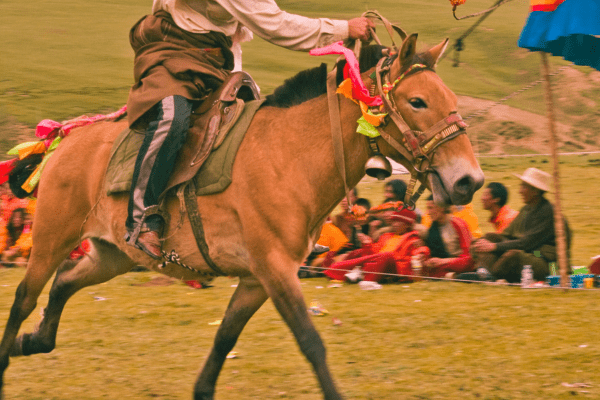The Tibetan Pony, a venerable breed of diminutive mountain equines, is celebrated for its remarkable strength and endurance. Despite extensive crossbreeding with the Spiti and Bhutia ponies, this ancient lineage has admirably preserved its distinct characteristics, maintaining its pure and unique identity.
History:
The Tibetan Pony, with a rich historical legacy, boasts an intricately intertwined lineage which connects numerous ancient equine lines. This breed’s heritage demonstrates its significance within different cultures’ interactions between each culture’s breeds of horses.
Ancestral Origins:
Thought to have descended primarily from ancient stock, the Tibetan Pony likely includes genetic influences from Mongolian Pony and Chinese horse breeds in its genetic make-up.
This blend of lineages has given the Tibetan Pony its distinct traits in terms of both physical appearance and temperament.
Sub-Breeds and Evolution:
Within this breed are notable variations such as the Nangchen horse, which has been kept purebred for centuries to preserve its distinct heritage and lineage.
Riwoche horses, an intriguing subtype, may represent a bridge between prehistoric wild horses and modern domesticated breeds – although some argue it could simply be domestic breeds with wild-type traits reverting.
Cultural and Historical Significance:
Horses, and particularly Tibetan Ponies, hold a prominent place in Tibetan culture and society as an icon of wealth and status, revered by everyone from farmers to the Dalai Lama himself and other religious figures.
Historical documents document how these ponies were given as gifts to Chinese emperors during the Ming and Tang dynasties, signifying diplomatic exchange between these regions.
The Tea-Horse Trade Route:
The Tibetan Pony played an essential part in historic trade routes, most notably the Tea-Horse Road between Tibet and Sichuan province of China.
Trade between Tibetan Ponies and Chinese Tea continued well into the mid 20th century, demonstrating the enduring relevance of this breed for regional commerce and trade.
Preservation and Modern-Day Status:
Today, efforts are being taken to preserve the unique heritage and characteristics of the Tibetan Pony while acknowledging both its historical and cultural importance.
As modernization advances, there is increasing recognition of the need to protect this breed against risks such as excessive crossbreeding and loss of its distinctive traits.

Characteristics:
The Tibetan Pony, an equine breed with small stature, stands as an incredible testament to nature’s engineering; their development was driven by their harsh environment in high altitude regions of Tibet.
Compact Strength and Stamina:
These ponies epitomize the saying’strength comes in small packages’. Their bodies have evolved to efficiently utilize oxygen from thin mountain air, giving them superior stamina and strength relative to their size.
Mountain Adaptability:
One of the breed’s hallmark characteristics is its exceptional sure-footedness, developed to navigate rugged Himalayan landscape. These ponies possess remarkable abilities in traversing steep and rocky terrain with ease; an invaluable trait necessary for their survival and utility in their native region.
Utilitarian Roles:
Light draft horses are often employed for lighter tasks such as carrying packs and providing reliable mounts, while their strength and endurance make them perfect for light draft duties like racing as well as herd management of livestock.
One popular variant used extensively in such capacities is Nangchen; prized for its speed and agility and often seen racing around races tracks or livestock management operations.
Different Physical Characteristics:
Head Structure: Featuring a distinct jawline and straight facial profile, the Tibetan Pony’s head structure serves as a visual signifier of its robustness.
Sensory Attributes: These ponies boast small ears with alert alertness, coupled with compact eyes for excellent sensory processing in their natural habitats.
Size and Build: The Tibetan Pony stands an average height of 12 to 14 hands (48 to 56 inches, 122 to 142 cm). Although small in stature, they are extremely strong and sturdy animals with well-muscled builds.
Body and Build: The breed features an athletic build with muscular but somewhat compact neck muscles supporting their deep chest and straight shoulders; all contributing to its impressive physical power.
Limbs: Their hindquarters are powerful, leading down to short yet sturdy legs with well-developed joints that enable agile movements while withstanding long journeys across rough terrains.
Uses and Adaptability:
Traditionally, they were utilized for transportation and agricultural work on steep mountain terrain like that found in the Himalayas.
These horses have also become prized competitors in endurance riding competitions and as children’s mounts due to their gentle temperaments.


Conservation and Current Situation:
The Tibetan Pony, like many indigenous breeds, faces challenges from modernization and crossbreeding. To preserve their unique genetic lineage and promote their significance in cultural heritage of Tibet. Efforts are underway to protect this rare animal.
Cultural Significance:
In Tibetan culture, these ponies are more than just animals; they are symbols of endurance, resilience, and the harmonious relationship between nature and the people of the highlands.
Festivals and events in Tibet often showcase these ponies, highlighting their significance in local traditions and folklore.

